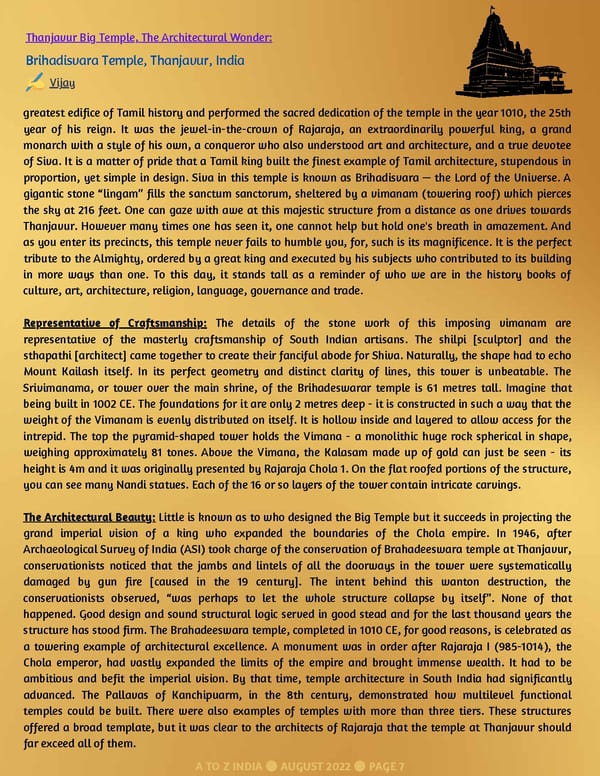Thanjavur Big Temple, The Architectural Wonder: Brihadisvara Temple, Thanjavur, India Vijay greatest edifice of Tamil history and performed the sacred dedication of the temple in the year 1010, the 25th year of his reign. It was the jewel-in-the-crown of Rajaraja, an extraordinarily powerful king, a grand monarch with a style of his own, a conqueror who also understood art and architecture, and a true devotee of Siva. It is a matter of pride that a Tamil king built the finest example of Tamil architecture, stupendous in proportion, yet simple in design. Siva in this temple is known as Brihadisvara — the Lord of the Universe. A gigantic stone “lingam” fills the sanctum sanctorum, sheltered by a vimanam (towering roof) which pierces the sky at 216 feet. One can gaze with awe at this majestic structure from a distance as one drives towards Thanjavur. However many times one has seen it, one cannot help but hold one's breath in amazement. And as you enter its precincts, this temple never fails to humble you, for, such is its magnificence. It is the perfect tribute to the Almighty, ordered by a great king and executed by his subjects who contributed to its building in more ways than one. To this day, it stands tall as a reminder of who we are in the history books of culture, art, architecture, religion, language, governance and trade. Representative of Craftsmanship: The details of the stone work of this imposing vimanam are representative of the masterly craftsmanship of South Indian artisans. The shilpi [sculptor] and the sthapathi [architect] came together to create their fanciful abode for Shiva. Naturally, the shape had to echo Mount Kailash itself. In its perfect geometry and distinct clarity of lines, this tower is unbeatable. The Srivimanama, or tower over the main shrine, of the Brihadeswarar temple is 61 metres tall. Imagine that being built in 1002 CE. The foundations for it are only 2 metres deep - it is constructed in such a way that the weight of the Vimanam is evenly distributed on itself. It is hollow inside and layered to allow access for the intrepid. The top the pyramid-shaped tower holds the Vimana - a monolithic huge rock spherical in shape, weighing approximately 81 tones. Above the Vimana, the Kalasam made up of gold can just be seen - its height is 4m and it was originally presented by Rajaraja Chola 1. On the flat roofed portions of the structure, you can see many Nandi statues. Each of the 16 or so layers of the tower contain intricate carvings. The Architectural Beauty: Little is known as to who designed the Big Temple but it succeeds in projecting the grand imperial vision of a king who expanded the boundaries of the Chola empire. In 1946, after Archaeological Survey of India (ASI) took charge of the conservation of Brahadeeswara temple at Thanjavur, conservationists noticed that the jambs and lintels of all the doorways in the tower were systematically damaged by gun fire [caused in the 19 century]. The intent behind this wanton destruction, the conservationists observed, “was perhaps to let the whole structure collapse by itself”. None of that happened. Good design and sound structural logic served in good stead and for the last thousand years the structure has stood firm. The Brahadeeswara temple, completed in 1010 CE, for good reasons, is celebrated as a towering example of architectural excellence. A monument was in order after Rajaraja I (985-1014), the Chola emperor, had vastly expanded the limits of the empire and brought immense wealth. It had to be ambitious and befit the imperial vision. By that time, temple architecture in South India had significantly advanced. The Pallavas of Kanchipuarm, in the 8th century, demonstrated how multilevel functional temples could be built. There were also examples of temples with more than three tiers. These structures offered a broad template, but it was clear to the architects of Rajaraja that the temple at Thanjavur should far exceed all of them. A TO Z INDIA AUGUST 2022 PAGE 7
 A TO Z INDIA - AUGUST 2022 Page 6 Page 8
A TO Z INDIA - AUGUST 2022 Page 6 Page 8